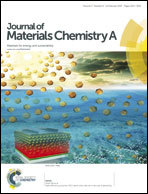The effect of graphene on the performance of an electrochemical flow capacitor†
Abstract
The electrochemical flow capacitor (EFC) plays an important role in the energy storage field. The potential and ease of large scale energy storage of an EFC makes it highly adaptable for grid-scale energy storage. Current working models for an EFC operate with activated carbon and other coarse-sized carbon-based materials as the input slurry material with limited device performance. Graphene, which has a large specific surface area and also offers the advantage of being in the nano-carbon form, is an excellent candidate for energy storage. In this paper, we investigate the efficiency enhancement of an EFC device when a graphene nanoplatelets-ionic electrolyte was used as the input slurry material for the flow device and charged–discharged; moreover, we have compared it with the coarse and conventional graphite-aqueous electrolyte slurry. The performance evaluation of a newly developed composition of graphene-based slurry with high capacitance was carried out and this slurry was used as both static and dynamic energy storage device. Thin film layers coated with this slurry have a high electrode specific capacitance greater than 300 F g−1, low-cost and a nickel-free composition with relatively low toxicity. The intermittent flow device has shown a device capacitance of 64.5 F with 2 V and a 5 mL graphene slurry input, which corresponds to an energy density of 14.3 W h L−1. The device with a graphite slurry has shown a capacitance of 2.3 F with 1.6 V and an energy density of 0.422 W h L−1. When the graphene nanoplatelets-based slurry was used in the actual EFC full flow device, it gives a capacitance of 1.08 F, 2 V device performance with a slurry input of 24 mL. Moreover, the graphene nanoplatelets-based slurry when used together with the ionic electrolyte shows a better device EFC performance (i.e. an energy density of 6 W h kg−1 (0.064 W h L−1)) when compared to using a coarse graphite-based slurry (device capacitance of 0.75 F with 1.6 V, and an energy density of 2.2 W h kg−1 (0.026 W h L−1)). Thus, this proof-of-concept study gives a significant difference in performance between a graphene slurry-based device and the conventional graphite slurry-based device. This model can be extended further by slurry material modification (such as the addition of materials displaying faradaic capacitance) to realize better performing flow-based devices.


 Please wait while we load your content...
Please wait while we load your content...